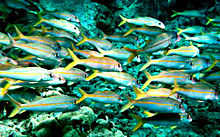Mullidae
| Goatfish | |
|---|---|
 |
|
| Yellowfin goatfish | |
| Scientific classification | |
| Kingdom: | Animalia |
| Phylum: | Chordata |
| Class: | Actinopterygii |
| Order: | Perciformes |
| Family: |
Mullidae Rafinesque, 1815 |
| Genera | |
The goatfishes are perciform fish of the family Mullidae. The family is also sometimes referred to as the red mullets, which also refers more narrowly to the genus Mullus.
The family name and the English common name "mullet" name are derived from Latin mullus, the red mullet; but other than the red mullet and the striped red mullet or surmullet, the English word mullet generally refers to a different family of fish, the Mugilidae or grey mullets.
Goatfishes are characterized by a pair of chin barbels, which contain chemosensory organs and are used to probe the sand or holes in the reef for food. Their bodies are deep and elongated, with forked tails and widely separated dorsal fins. The first dorsal fin has 6-8 spines; the second dorsal has one spine and 8-9 soft rays, shorter than anal fin. Spines in anal fin 1 or 2, with 5-8 soft rays. They have 24 vertebrae.
Many goatfishes are brightly colored. The largest species, the dash-and-dot goatfish (Parupeneus barberinus), grows to 60 cm in length; most species are less than half this size. Within the family are six genera and about eighty-six species.
Goatfishes are distributed worldwide in tropical, subtropical and temperate waters. Goatfishes occur in a range of habitats. Most species are associated with the bottom of the littoral, but some species of Upeneus can be deep; for example the goatfish Upeneus davidaromi can be found to depths of 500 m. Tropical goatfishes live in association with coral reefs. Some species, such as the freckled goatfish (Upeneus tragula) enter estuaries and rivers, although not to any great extent.
Goatfishes are tireless benthic feeders, using a pair of long chemosensory barbels ("whiskers") protruding from their chins to rifle through the sediments in search of prey. They feed on worms, crustaceans, molluscs and other small invertebrates. Other fish shadow the active goatfish, waiting patiently for any overlooked prey. For example, in Indonesia large schools of the l goldsaddle goatfish (Parupeneus cyclostomus) and moray eels hunting together. This behavior is known as shadow feeding or cooperative hunting. By day, many goatfishes will form large schools of inactive (non feeding) fish; these aggregates may contain both conspecifics and heterospecifics. For example, the yellowfin goatfish (Mulloidichthys vanicolensis) is often seen congregating with bluestripe snappers (Lutjanus kasmira). All goatfishes have the ability to change their coloration depending on their current activity. One notable example, the diurnal goldsaddle goatfish (Parupeneus cyclostomus) will change from a lemon-yellow to a pale cream whilst feeding.
...
Wikipedia
